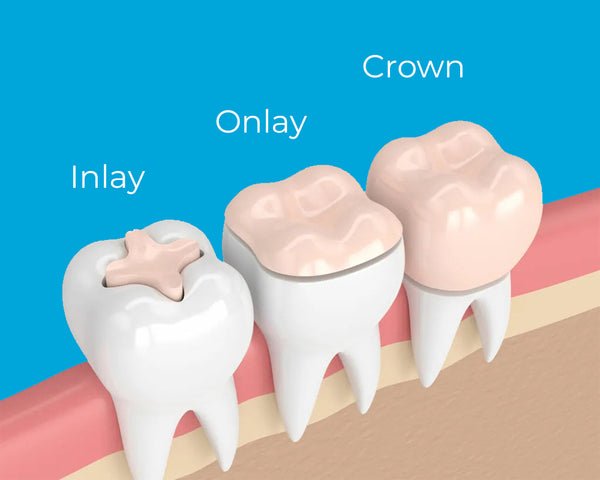A partial crown, also known as an onlay or three-quarter crown, is a dental restoration that covers a portion of a damaged tooth. Unlike a full crown that encases the entire tooth, a partial crown is a more conservative option that preserves more of the natural tooth structure. This type of crown is often used when a tooth has a large filling or a broken cusp, providing both strength and aesthetics. With advancements in dental technology, partial crowns offer a durable and natural-looking solution for restoring a tooth’s function and appearance.
What is a Partial Crown: A Comprehensive Guide
Welcome, curious minds, to our exploration of the fascinating world of partial crowns! In this detailed guide, we will delve into the intricacies of what a partial crown is, why you might need one, the different types available, the procedure involved, and the benefits they offer. So, grab a seat and let’s uncover the secrets of partial crowns together!
Understanding Partial Crowns
First things first, what exactly is a partial crown? A partial crown, also known as an onlay or three-quarter crown, is a type of dental restoration that is used to repair a tooth that has been damaged due to decay or trauma. It is called a “partial” crown because it covers only a portion of the tooth, unlike a full crown that covers the entire tooth.
Partial crowns are typically made from materials such as porcelain, ceramic, gold, or a combination of these materials. They are custom-made to match the color and shape of your natural teeth, ensuring a seamless and natural-looking restoration.
Why You Might Need a Partial Crown
There are several reasons why a dentist may recommend a partial crown for a patient. One common scenario is when a tooth has a large cavity or a fracture that is too extensive to be repaired with a simple filling but not severe enough to require a full crown. In such cases, a partial crown can be a perfect solution to restore the tooth’s strength and function.
Another situation where a partial crown may be necessary is when a tooth has undergone a root canal treatment. Since a tooth that has had a root canal is more susceptible to fracturing, a partial crown can help protect and support the tooth, preventing further damage.
The Different Types of Partial Crowns
Partial crowns come in different types, each with its own unique characteristics and benefits. The two main types of partial crowns are inlays and onlays.
Inlays:
Inlays are partial crowns that fit inside the cusps, or the raised points, of a tooth. They are used to repair damage that is confined to the center of the tooth, such as a large cavity. Inlays are custom-made in a dental laboratory and then bonded to the tooth by the dentist.
Onlays:
Onlays, on the other hand, cover one or more cusps of a tooth and are used when the damage extends to the chewing surface or one or more of the cusps. Onlays are also custom-made and provide more coverage and support than inlays.
The Procedure for Getting a Partial Crown
Now that you understand what a partial crown is and why you might need one, let’s walk through the procedure for getting a partial crown. The process typically involves the following steps:
1. Consultation and Examination:
Your dentist will examine the affected tooth and discuss your treatment options with you. If a partial crown is the recommended course of action, they will explain the procedure and answer any questions you may have.
2. Tooth Preparation:
Next, the dentist will prepare the tooth by removing any decayed or damaged areas and shaping the tooth to accommodate the partial crown. An impression of the tooth will then be taken to create a custom-made partial crown that fits perfectly.
3. Temporary Crown:
While the permanent partial crown is being fabricated, the dentist will place a temporary crown to protect the tooth. It is important to take care of the temporary crown and avoid chewing on hard or sticky foods to prevent it from coming loose.
4. Placement of the Partial Crown:
Once the custom partial crown is ready, you will return to the dentist for the final placement. The dentist will ensure that the partial crown fits properly, matches your natural teeth, and then permanently bond it to the tooth using dental cement.
The Benefits of Partial Crowns
Partial crowns offer a range of benefits that make them a popular choice for restoring damaged teeth. Some of the key advantages of partial crowns include:
1. Preservation of Tooth Structure:
Unlike full crowns that require more tooth structure to be removed, partial crowns allow for more conservative preparation, preserving more of the natural tooth structure.
2. Strength and Durability:
Partial crowns provide excellent strength and durability, restoring the tooth’s function and preventing further damage.
3. Aesthetics:
Partial crowns are custom-made to match the color and shape of your natural teeth, ensuring a seamless and natural-looking restoration.
4. Comfort:
Once in place, partial crowns feel comfortable and natural, allowing you to chew and speak with ease.
5. Longevity:
With proper care and regular dental check-ups, partial crowns can last for many years, providing a lasting solution for damaged teeth.
And there you have it, a comprehensive guide to understanding what a partial crown is and why it is a valuable dental restoration option. Whether you have a tooth that needs repair or you simply want to learn more about dental procedures, partial crowns offer a versatile and effective solution for restoring damaged teeth. If you think you may benefit from a partial crown, consult with your dentist to explore your options and take the first step towards a healthier, happier smile!
Thank you for joining us on this journey through the world of partial crowns. We hope you found this guide informative and engaging. Remember, your smile is worth protecting, so don’t hesitate to seek the care you need to keep it shining bright!
Do NOT Crown Your Tooth! – Partial Crown (Cosmetic Dentistry)
Frequently Asked Questions
What is a partial crown and when is it recommended?
A partial crown, also known as an onlay or three-quarter crown, is a dental restoration that covers only part of a tooth. It is recommended when a tooth has a significant amount of decay or damage that cannot be fixed with a filling but does not require a full crown.
How is a partial crown different from a full crown?
A partial crown covers only a portion of the tooth, while a full crown covers the entire tooth. Partial crowns preserve more of the natural tooth structure as they require less tooth preparation compared to full crowns.
What are the benefits of getting a partial crown?
Partial crowns provide a more conservative alternative to full crowns by preserving more of the natural tooth structure. They are also aesthetically pleasing as they can be matched to the color of the surrounding teeth.
Is getting a partial crown a painful procedure?
Getting a partial crown is not typically painful as the dentist will numb the area before the procedure. Some patients may experience mild discomfort or sensitivity after the procedure, which can be managed with over-the-counter pain medication.
Final Thoughts
A partial crown, also known as an onlay or inlay, is a dental restoration that covers only a portion of a tooth. It offers a conservative option for addressing extensive damage or decay while preserving as much natural tooth structure as possible. This custom-made restoration is designed to blend seamlessly with the rest of the tooth, providing both strength and aesthetic appeal. With a partial crown, patients can restore the function and appearance of their teeth with a minimally invasive approach.
 home depot coupons moving helping customers save on essential home supplies
home depot coupons moving helping customers save on essential home supplies 
